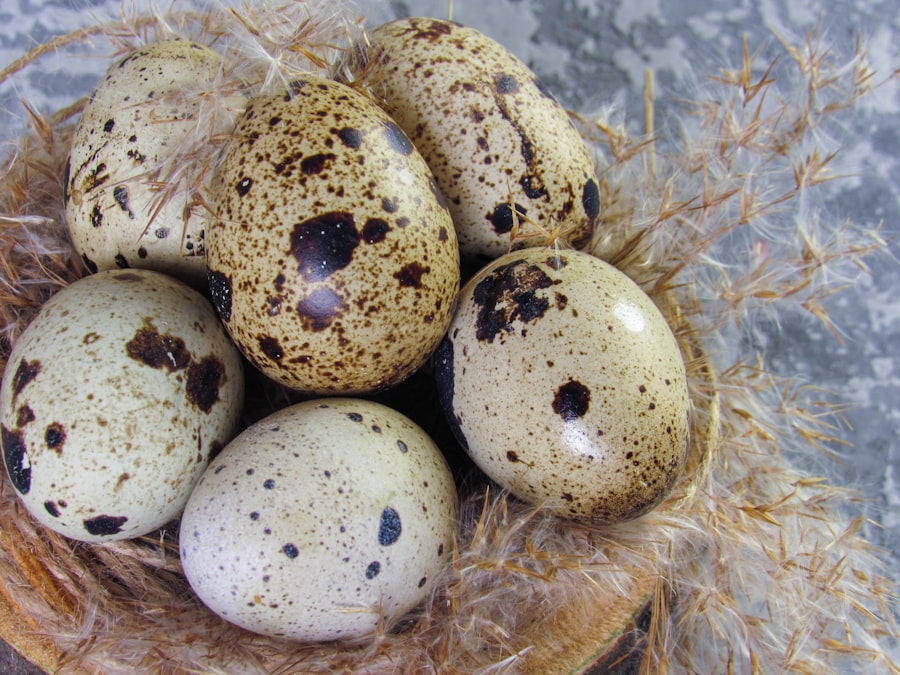Breeding ratio refers to the number of male and female quails in a breeding group. The ideal breeding ratio for Coturnix quails is generally 1:4, which means one male for every four females. This ratio ensures that each female has a fair chance of being fertilized by the male, leading to a higher success rate in breeding. It is important to note that the breeding ratio may vary depending on the specific goals of the breeder, such as egg production, meat production, or genetic diversity.
In a breeding group, the male quail’s primary role is to fertilize the eggs laid by the females. Therefore, having the right number of males to females is crucial in ensuring successful breeding and maintaining a healthy population. Understanding the breeding ratio is essential for quail breeders to achieve their desired outcomes and prevent issues such as inbreeding or low fertility rates.
Table of Contents
- 1 Importance of Maintaining the Right Breeding Ratio
- 2 Factors to Consider in Determining the Breeding Ratio
- 3 Tips for Achieving a Successful Breeding Ratio
- 4 Monitoring and Adjusting the Breeding Ratio
- 5 Common Mistakes to Avoid in Coturnix Quail Breeding Ratio
- 6 The Key to Successful Coturnix Quail Breeding Ratio
- 7 FAQs
Key Takeaways
- The ideal breeding ratio for Coturnix quail is 1 male to 4-6 females
- Maintaining the right breeding ratio is crucial for maximizing fertility and egg production
- Factors to consider in determining the breeding ratio include age, health, and genetics of the quail
- Providing adequate space, nutrition, and environmental conditions are essential for achieving a successful breeding ratio
- Regular monitoring and adjustment of the breeding ratio is necessary to ensure optimal breeding results
- Common mistakes to avoid in Coturnix quail breeding ratio include overcrowding, improper nutrition, and neglecting to monitor the ratio
- In conclusion, maintaining the right breeding ratio is key to successful Coturnix quail breeding and ensuring a healthy and productive quail population
Importance of Maintaining the Right Breeding Ratio
Maintaining the right breeding ratio is crucial for the overall health and productivity of a quail population. When the breeding ratio is unbalanced, it can lead to various problems such as low fertility rates, inbreeding, and decreased egg production. By ensuring the correct ratio of males to females, quail breeders can maximize their breeding efforts and achieve better results in terms of egg production, meat production, and genetic diversity.
A balanced breeding ratio also promotes a harmonious social environment within the quail population. When there are too few males in a breeding group, it can lead to increased aggression and competition among the males, which can stress the females and negatively impact their reproductive success. On the other hand, having too many males in a breeding group can result in over-breeding and exhaustion of the females. Therefore, maintaining the right breeding ratio is essential for the overall well-being of the quail population.
Factors to Consider in Determining the Breeding Ratio
Several factors should be considered when determining the breeding ratio for Coturnix quails. These factors include the breeder’s specific goals, such as egg production, meat production, or genetic diversity, as well as the size and age of the quails in the breeding group. Additionally, the availability of space, resources, and management capabilities should also be taken into account when determining the breeding ratio.
The age and health of the quails are important considerations when determining the breeding ratio. Older quails may have decreased fertility rates, so it is essential to adjust the breeding ratio accordingly to ensure successful breeding. Additionally, the size of the breeding space and the availability of resources such as nesting areas and feeders should be considered to prevent overcrowding and competition within the breeding group.
Genetic diversity is another crucial factor to consider when determining the breeding ratio. Maintaining a diverse gene pool within the quail population is essential for preventing genetic abnormalities and promoting overall population health. Therefore, breeders should carefully consider the genetic makeup of their quails when determining the breeding ratio.
Tips for Achieving a Successful Breeding Ratio
Achieving a successful breeding ratio for Coturnix quails requires careful planning and management. One of the most important tips for achieving a successful breeding ratio is to regularly assess the fertility rates of the breeding group. By monitoring the number of fertile eggs laid by the females, breeders can adjust the breeding ratio as needed to optimize reproductive success.
Another tip for achieving a successful breeding ratio is to provide adequate space and resources for the quails. Overcrowding can lead to increased stress and competition within the breeding group, which can negatively impact fertility rates and overall productivity. Providing ample nesting areas, feeders, and water sources can help maintain a balanced and harmonious breeding environment.
Additionally, breeders should carefully select their breeding stock to ensure genetic diversity and overall reproductive success. Choosing healthy, genetically diverse quails for breeding can help prevent issues such as inbreeding and genetic abnormalities. By selecting high-quality breeding stock, breeders can improve their chances of achieving a successful breeding ratio.
Monitoring and Adjusting the Breeding Ratio
Monitoring and adjusting the breeding ratio is essential for maintaining a healthy and productive quail population. Breeders should regularly assess the fertility rates of their quails by collecting and candling eggs to determine which ones are fertile. By keeping track of fertility rates, breeders can identify any imbalances in the breeding ratio and make necessary adjustments to optimize reproductive success.
When monitoring the breeding ratio, breeders should pay attention to any signs of stress or aggression within the breeding group. Aggressive behavior among quails can indicate an unbalanced breeding ratio or overcrowding, which can negatively impact fertility rates. By observing the behavior of the quails, breeders can identify any issues with the breeding ratio and take appropriate measures to address them.
Adjusting the breeding ratio may involve adding or removing males from the breeding group to achieve a more balanced ratio. Breeders should carefully consider the age, health, and genetic diversity of their quails when making adjustments to the breeding ratio. By regularly monitoring and adjusting the breeding ratio, breeders can maintain a healthy and productive quail population.
Common Mistakes to Avoid in Coturnix Quail Breeding Ratio

There are several common mistakes that breeders should avoid when managing the breeding ratio for Coturnix quails. One common mistake is maintaining an unbalanced breeding ratio, such as having too few or too many males in a breeding group. An unbalanced breeding ratio can lead to decreased fertility rates, increased aggression, and overall reproductive issues within the quail population.
Another common mistake is neglecting to monitor and adjust the breeding ratio as needed. Failing to regularly assess fertility rates and observe quail behavior can result in missed opportunities to optimize reproductive success. Breeders should be proactive in monitoring and adjusting the breeding ratio to maintain a healthy and productive quail population.
Additionally, breeders should avoid using unhealthy or genetically inferior quails for breeding purposes. Selecting poor-quality breeding stock can lead to decreased fertility rates and overall reproductive issues within the quail population. It is essential for breeders to carefully select their breeding stock to ensure genetic diversity and overall reproductive success.
The Key to Successful Coturnix Quail Breeding Ratio
In conclusion, maintaining the right breeding ratio is essential for achieving successful Coturnix quail breeding outcomes. By understanding the factors that influence the breeding ratio and following tips for achieving a successful ratio, breeders can optimize reproductive success and maintain a healthy quail population. Regularly monitoring and adjusting the breeding ratio is crucial for preventing common mistakes such as unbalanced ratios or using poor-quality breeding stock. By carefully managing the breeding ratio, breeders can ensure high fertility rates, genetic diversity, and overall productivity within their quail population.
If you’re interested in learning more about the optimal breeding ratio for Coturnix quail, you might also want to check out this informative article on where to put a chicken coop. Understanding the best location for your coop can have a significant impact on the health and productivity of your quail, making it an essential consideration for any breeder.
FAQs
What is the ideal breeding ratio for coturnix quail?
The ideal breeding ratio for coturnix quail is one male to every three to five females. This ratio helps to ensure successful breeding and minimizes aggression among the birds.
Why is the breeding ratio important in coturnix quail breeding?
The breeding ratio is important in coturnix quail breeding because it affects the success of mating and egg production. A proper breeding ratio ensures that each female has access to a male for mating, leading to a higher fertility rate and better hatchability of eggs.
What happens if the breeding ratio is not maintained in coturnix quail breeding?
If the breeding ratio is not maintained in coturnix quail breeding, there may be increased aggression among the birds, lower fertility rates, and decreased hatchability of eggs. It is important to monitor the breeding ratio to ensure the health and productivity of the quail flock.
How can I determine the sex of coturnix quail for breeding ratio purposes?
The sex of coturnix quail can be determined by examining their physical characteristics. Males typically have a rust-colored throat and a distinct call, while females have a more mottled appearance and do not have the rust-colored throat. It is important to accurately sex the quail to maintain the proper breeding ratio.
Meet Walter, the feathered-friend fanatic of Florida! Nestled in the sunshine state, Walter struts through life with his feathered companions, clucking his way to happiness. With a coop that’s fancier than a five-star hotel, he’s the Don Juan of the chicken world. When he’s not teaching his hens to do the cha-cha, you’ll find him in a heated debate with his prized rooster, Sir Clucks-a-Lot. Walter’s poultry passion is no yolk; he’s the sunny-side-up guy you never knew you needed in your flock of friends!







